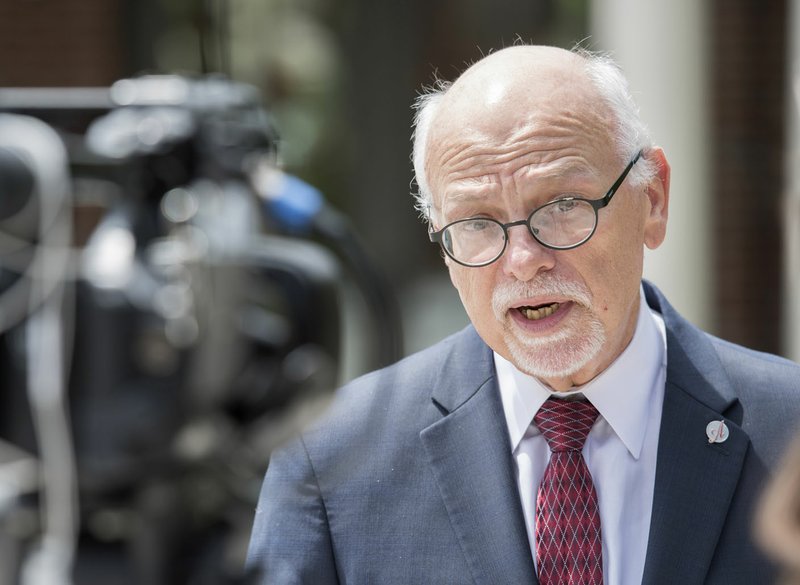FAYETTEVILLE -- A pilot program offering mentoring and need-based grants to 300 in-state students will be part of efforts to boost graduation rates at the University of Arkansas, Fayetteville, the school's top administrator, Chancellor Joe Steinmetz, said Thursday.
"Unmet need is as much a driver of retention as pre-college academic readiness," Steinmetz said in a campus speech describing a newly released academic plan and the importance of measuring progress towards university goals "in a time of tight budgeting."
Steinmetz, chancellor since January 2016 after serving as executive vice president and provost at Ohio State University, defined unmet financial need as the cost of attendance minus a family's contribution and grant aid, calling it "whatever need is left."
He said less than 3 percent of Arkansas residents graduated within four years if their unmet need topped $15,000. Extending the graduation window to six years, less than 10 percent earned degrees, based on data from 2006-15, Steinmetz said.
"The greater the unmet need, the more likely a student is to drop out," Steinmetz said.
The Arkansas Student Talent Enrichment Program will have a goal of working with 300 students projected to benefit most from the support, Steinmetz said. He also described continuing fundraising efforts for both need-based and merit-based scholarships.
Another effort aimed at boosting student success involves the opening of a new on-campus academic support center this spring, he said.
UA last fall reported a six-year graduation rate of 64.5 percent for students entering in fall 2010, an all-time high for the school. UA also reported a four-year graduation rate of 42.3 percent.
But some peer schools in the survey data reported higher graduation rates. The University of Missouri reported a six-year graduation rate of 68 percent, and the University of Oklahoma reported a six-year rate of 67.5 percent.
"Within five years, I expect to see a 5 to 10 percent increase in our graduation rate," Steinmetz said.
The university announced preliminary enrollment this fall of 27,558 total students, up 1.3 percent from 27,194 a year earlier.
From fall 2005 through fall 2015, UA's total enrollment increased by 50 percent, but Steinmetz spoke about slowing enrollment growth.
"In an era when state funding has not kept pace with inflation, this growth has helped generate precious revenue and helped to improve our educational quality," Steinmetz said. "But the end is in sight. We cannot continue to grow as we have for the last 10 years or so."
He said continued growth would require "major investments in infrastructure, and using steep tuition increases to pay for it is not an option either."
On Tuesday, UA rolled out an academic plan to boost student success and accomplish various other campus goals. Steinmetz emphasized the importance of tracking progress.
"We simply must be able to measure the effectiveness of our programs. In a time of tight budgeting, accountability is crucial," Steinmetz said.
Campus goals in the plan extend beyond supporting students, with "investing in faculty excellence" one of eight campus priorities announced last year.
Steinmetz said about $8.9 million has gone to "salary increases for faculty and staff, so that we could make some progress towards closing the gap between our salaries and the salaries of our benchmark schools." Steinmetz said faculty salary increases totaled about $4.4 million.
Some of the money for raises came from tuition revenue that followed the increased enrollment, while another source of funding was a 1 percent reallocation of administrative and academic unit budgets towards university goals, Steinmetz said.
Last year, Steinmetz said 1 percent reallocations would take place for three consecutive years. Athletics did not take part, UA officials said. Steinmetz said Thursday that UA's athletic department contributed $750,000 to a fund supporting interdisciplinary research.
This year, "we plan to get ahead of the budget process a bit so we can identify and allocate resources earlier and more strategically," Steinmetz said.
In response to a question about students and the Deferred Action for Childhood Arrivals immigration policy, Steinmetz restated support for its continuation.
The temporary authorization for some illegal immigrants who arrived in the United States as children, a policy begun under President Barack Obama's administration, is ending under President Donald Trump unless action is taken by federal lawmakers.
"There are great contributions that are made by these individuals, and I think it's a mistake to just simply turn away and turn aside," Steinmetz said. "So we'll do all we can to make sure DACA students have a home, not only here but everywhere in this country."
Asked about the $120 million Walton Family Charitable Support Foundation gift supporting art education, announced last month, Steinmetz described it as benefiting all students.
"It doesn't matter if you're a physicist or a neuroscientist, or if you're in the humanities or the arts," said Steinmetz, a behavioral neuroscientist himself. "The creative process will touch and improve everybody. And so it is the goal, I think fundamentally, for that gift to touch the entire university by providing the means to have those experiences."
Metro on 09/15/2017

